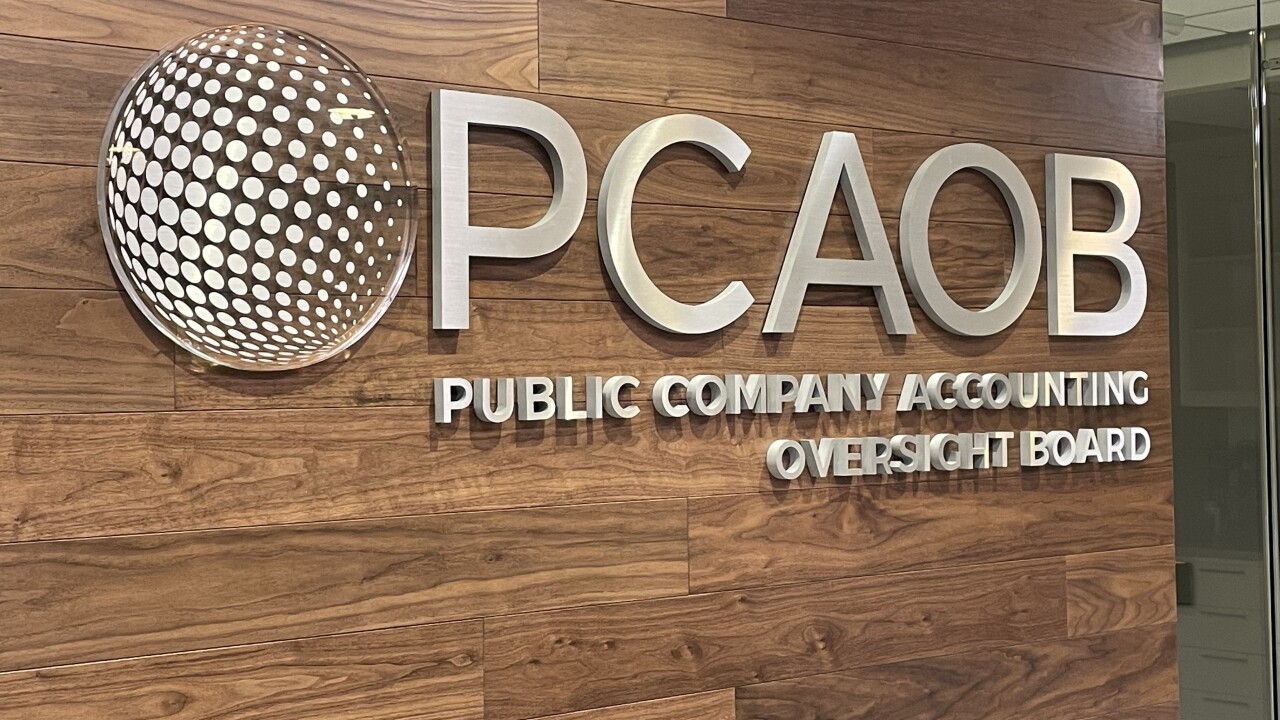The Public Company Accounting Oversight Board has released a
“The inspection team considered certain of the deficiencies that it observed to be audit failures,” said the report. “Specifically, certain of the identified deficiencies were of such significance that it appeared that the firm, at the time it issued its audit report, had failed to obtain sufficient appropriate audit evidence to support its audit opinion on the financial statements and/or on the effectiveness of internal control over financial reporting ("ICFR"). In addition, one of the identified deficiencies, which occurred in an audit in which the firm played a role but was not the principal auditor, was of such significance that it appeared that the firm had not obtained sufficient appropriate audit evidence to fulfill the objectives of its role in the audit.”
In one audit of an unidentified issuer, the PCAOB said PwC failed to perform sufficient procedures to evaluate whether the issuer's investment in another entity was accounted for properly. The firm failed to perform any procedures, beyond inquiry of management and reading an issuer-prepared memorandum, to evaluate the issuer's conclusion that its investment in the entity should be accounted for on the cost method. The firm also failed to perform procedures, beyond inquiry of management, to evaluate the issuer's conclusion that its investment in, and receivables from, this entity were not impaired, even though the firm’s work papers included a number of potential impairment indicators, including indications that the entity lacked sufficient cash to fund its operations for the next 12 months.
With the audit of another client, the PCAOB said PwC failed to obtain sufficient appropriate audit evidence to support its audit opinion on the financial statements. “The issuer discontinued production of a significant product line during the prior year and introduced a new product line to replace it,” the PCAOB explained. “There were no sales of the discontinued product line during the last nine months of the year under audit. The issuer calculated a separate reserve for this product line based on factors and assumptions that were specific to this product line. The firm failed to test, beyond inquiry, the significant assumptions management used to calculate this separate reserve, which was approximately one-third of the recorded value of the product inventory.”
In addition, with the same client, PwC identified revenue and accounts receivable as significant accounts, and then used the issuer's internal audit group to test whether revenue recorded near year end was recorded in the appropriate period, and also to test the subsequent cash receipts for accounts receivable for which confirmations were not returned. However, PwC failed to appropriately supervise the work of the internal auditors, as the internal auditors independently selected the transactions for the cut-off testing, and the firm did not direct or test any of the work performed by the internal auditors in these areas.
With the audit of a third client, the PCAOB noted that PwC failed in several respects to obtain sufficient appropriate audit evidence to support its audit opinions on the financial statements and the effectiveness of internal controls over financial reporting. For example, the PCAOB noted that the firm failed to perform sufficient procedures to test the controls related to the issuer's process for determining whether a legal entity is a variable interest entity and, if so, whether it needed to be consolidated.
The issuer engaged an external consultant to assist with the implementation of the new accounting standard related to the consolidation of VIEs. The client also engaged the same external consultant to perform its internal audit function, including the testing of internal controls related to the issuer's process for analyzing legal entities based on the new accounting standard. PwC used the work of the external consultant to reduce the extent of its testing of internal controls in this area, the PCAOB noted, but there was no evidence in the audit documentation, and no persuasive other evidence, that the firm had assessed the effect of the consultant's services on the consultant's objectivity.
The firm also failed to test the completeness of the list of VIEs that the issuer used in determining which VIEs should be consolidated after the initial adoption of the new accounting standard. For certain financial instruments without readily determinable fair values, when the issuer's standard model produced fair value measurements that the issuer considered to be unreasonable, the issuer developed its fair value measurements using assumptions based on certain transactions that had occurred in the first quarter of the prior year. In addition, for certain of these financial instruments, when the issuer expected losses to be realized, the issuer adjusted the fair value measurement based, in part, on the performance of the underlying collateral. The firm failed to perform sufficient procedures to test the fair value measurements of these financial instruments and the related controls in several respects.
PwC defended its actions in response to the PCAOB report but said it had also taken many actions to improve audit quality in the past several months. “We believe that as with any audit process, judgments are necessarily involved in the inspection process and professionals can reach different conclusions about the adequacy of audit evidence in a particular circumstance,” wrote PwC U.S. chairman and senior partner Bob Moritz and U.S. assurance leader Tim Ryan. “In those instances where such differences exist related to the inspection observations detailed in this report, they generally related to the significance of the observation in relation to the audit evidence taken as a whole rather than the specific nature of the observation. So, while we may disagree with the significance of inspection observations in certain cases, we have taken all of the Board’s observations into account in formulating our plan to continuously improve audit quality.”





